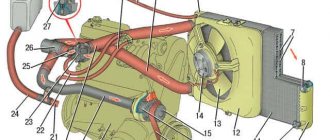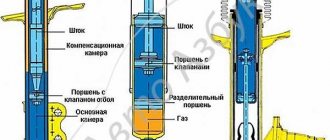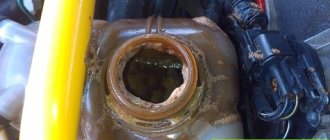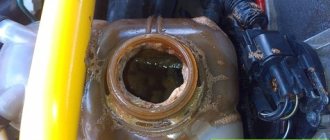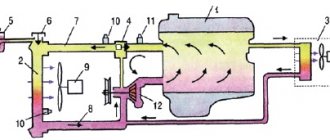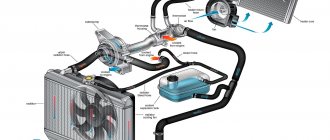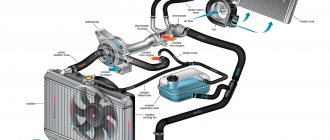Hello everyone, I have antifreeze dripping onto my passenger floor mat, quite a lot! The windows are constantly closing in and you can smell the antifreeze! what could it be and how to deal with it? VAZ 2114-2011, thanks in advance.. VAZ 2114 is leaking antifreeze into the interior.
Similar articles
23 comments on “VAZ 2114 antifreeze is leaking into the interior. I have antifreeze dripping on my passenger floor mat.”
look at the heater radiator
Look at the stove tap.
Even a fool can guess this.
Warm up the car until the fan comes on and tighten the clamps on the heater hoses
Radiator and faucet
If the heater radiator were leaking, it would leak onto the driver's mat, in any case, something is wrong with it, most likely the pipes that come from the heater radiator could still be
Maybe because of the rocker?
Fuck, why look into the bastard or something, it will be obvious right away,
If you got into the stove, then everything needs to be changed
I had the same thing on my 2115 - the heater radiator was leaking from the hoses side. But the tap is on the wall and there is no way to reach the rug.
maybe the radiator is leaking, or maybe the pipes are cracked under the clamps
Either the radiator or the pipes. The driver's side faucet is leaking
It's sad it's such an ass to change it
Change the valve, pipes in the cabin and the radiator. And you’ll forget how you dry everything. 3 thousand should be enough for everything, although I’m not sure)
Thank you very much guys, I will follow your advice and replace the pipes and radiator! only it’s not convenient to change the radiator at all..)) but the stench from antifreeze is already in the nose)))
Sergey, as soon as he gets it.
Nikolay, remove the panel completely, tinker with the panel there, remove it for five minutes and the reason is the radiator pipes, but the faucet is a very rare case of dripping, most likely these pipes are leaking or burst or the clamp does not press
Jonik, please explain HOW the coolant dripping from the faucet gets onto the driver's mat?! If the faucet itself is on the right side...
I didn't talk about the faucet! My heater radiator was leaking on the left side in the lower part, and accordingly it was dripping onto the rug! I replaced the radiator and everything is fine
The radiator is leaking, the pipes are snotty. Everything flows from the faucet UNDER THE Rug....
What are the reasons for such a dangerous effect:
- The stove tap broke.
- Rupture of the material structure or surface of the heater radiator.
How to fix
Now that the causes have been identified, it is worth considering possible solutions to the problem. Before we begin, it should be noted that these reasons can easily be eliminated independently and it is not necessary to contact a car service. Let's look at how to solve the problem of antifreeze on the interior carpet.
Stove faucet
In the process of replacing the stove valve
In this case, the leakage of antifreeze may be caused by the fact that the heater faucet has worn out. Mostly, the leak will form under the driver's mat and occurs only in a certain operating mode of the heater. This malfunction can be treated simply by replacing the heater tap.
Heater radiator
Faulty heater radiator
The second most common reason is a leak from the heater core. Here you need to be careful and quickly fix the problem, since antifreeze gets not only onto the interior mats, but also affects its location.
So, if coolant leaks out, there is a possibility of damaging other components, especially the main one - the electronic control unit.
Simplified operation of the VAZ 2114 cooling system
Cooling diagram for VAZ 2114: 1 – element in the form of a plug for the expansion tank;
2 – expansion tank; 3 – hose for draining liquid from the pipe; 4 – hose passing between the radiator and the expansion tank; 5 – hose leading from the radiator; 6 – tank to the left of the radiator; 7 – aluminum tube; 8 – plug systems; 9 – tank to the right of the radiator; 10 – drain plug; 11 – middle of the radiator; 12 – casing for electric fan; 13 – plastic wings of the electric fan; 14 – electric motor; 15 – toothed pump pulley; 16 – pump impeller; 17 – camshaft drive belt; 18 – engine block; 19 – pump pipe; 20 – radiator hose with supply function; 21 – heater radiator hose with drain function; 22 – hose supplying coolant to the throttle pipe; 23 – exhaust pipe; 24 – hose for refilling; 25 – heater radiator hose with supply function; 26 – thermostat; 27 – coolant temperature sensor; 28 – coolant level indicator sensor. The coolant enters the water jacket of the engine block through the pipes. In the water jacket, the coolant circulates in a small circle until the engine (and therefore the coolant) reaches a temperature of 95 degrees Celsius.
At this moment, the thermostat opens and coolant is delivered through the pipes to the radiator. The radiator removes excess heat from the coolant. Excess hot coolant returns to the expansion tank.
The entire cooling system is under high pressure of 1.2-1.8 atmospheres, due to the operation of the pump and the increase in coolant volume due to heating.
From the above text we conclude: malfunctions of the cooling system are not easy to detect with small leaks, since the coolant evaporates almost immediately, having a high temperature, and work to find the location of the leak sometimes requires the intervention of a professional.
Attention!!!
All work on the cooling system must be carried out with the car turned off and the coolant cooled down.
Step 1. The pipe burst
Since the pipes are the “blood vessels” of the car, failure of any of them will result in loss of coolant.
This malfunction is clearly visible on a warm engine while driving. A large amount of steam appears from under the hood. The burst pipe is clearly visible.
But there are times when the coolant leak is small. Then, first of all, attention should be paid to the articulation of the pipes with the vehicle components.
When using coolant in the form of antifreeze or antifreeze, a characteristic oily coating remains in the leak areas.
Step 2. Radiator problem
A radiator malfunction is extremely difficult to detect. At the site of a coolant leak, a large amount of scale sometimes forms, making it difficult to see the location of the damage.
Pay attention to the tightness of the filler plug. If everything is OK with the tightness, then to check you will need a compressor with a pressure gauge or a pump.
Disconnect the upper pipe and connect the compressor. The pipe must be plugged. We create excess pressure and see where the leak appears. We dismantle the radiator. We take it to a specialized service center, where they will check it again under pressure, find a leak (there may be more than one) and weld it with a special compound.
Step 3. Gases in the expansion tank
This malfunction occurs due to the entry of exhaust gases (a specific smell is clearly felt in the car interior) into the cooling system under enormous pressure of 90-96 kPa.
The reason is a faulty gasket between the valve head and the cylinder block. It is caused by coolant leaking from under the expansion tank cap.
The check is quite simple. We start the engine on a cold car, remove the cap from the expansion tank and sharply press the accelerator (in common parlance, the gas pedal).
If the coolant rises sharply, the gasket must be replaced. Stop operating the vehicle immediately until the problem is resolved.
Sometimes the expansion tank cap, due to spring wear, may not withstand coolant pressure.
We recommend reading: Antifreeze in oil
Step 4. Gray emulsion instead of oil
If you notice that your car has started to “trouble”, a large amount of steam comes out of the exhaust pipe, which smells like coolant. The amount of coolant is constantly decreasing and when checking the oil dipstick, it is clear that the oil has turned into a gray emulsion.
All this indicates a malfunction of the cooling jacket of the engine cylinder block. I categorically do not recommend operating the car in this condition! In addition to the problem with the cooling system, the lubrication of all moving parts of the engine is impaired, which can easily lead to its breakdown.
Step 5. Antifreeze in the cabin
In addition to cooling the engine, the coolant is used to heat the vehicle interior. If the interior radiator or the pipes leading to it malfunction, a large amount of coolant leaks onto the floor.
The malfunction is very unpleasant, as it entails disassembling almost the entire front part of the car's interior.
How does poisoning occur?
Immediately after taking ethylene glycol, a short-term state of mild alcoholic intoxication may occur. A person can fall asleep or feel quite satisfactory for 8-12 hours without noticing the first symptoms of poisoning.
After 12-15 hours, symptoms develop that indicate a deterioration of the condition:
- severe headaches
- dizziness, loss of coordination of movements
- attacks of nausea, vomiting
- sharp and/or cramping pain in the abdomen, lower back, and muscles
- flickering of “flies” before the eyes, objects are seen unclearly, double, short-term onset of blindness
- the surface temperature of the skin decreases, it becomes pale or gray, so-called “marbled”
- spasms of the upper and lower extremities
- lowering blood pressure
- severe stimulation of the nervous system or the onset of a coma
Fix it yourself or go to a service station?
Once again I want to draw your attention, this is very important! All work on replacing cooling system elements is carried out exclusively with the engine turned off and the coolant cooled down.
You can replace the pipes, thermostat, radiator filler cap, and expansion tank cap yourself. Remove the filler cap on the radiator. Unscrew the drain plug on the engine and drain the coolant into a clean container.
As for replacing the gasket between the valve head and the piston block, repairing a rotten engine cooling jacket and repairing radiators, these works are best done at specialized stations.
Since such repairs will require the use of specific tools and the necessary experience and knowledge.
Antifreeze vapors are harmful to health!
Smudges are visible on the upholstery, but traces of antifreeze are more clearly visible on the mat itself
Of course, soaking the interior carpet of a VAZ-2114 with antifreeze entails consequences. The most unpleasant consequence is the smell of coolant when driving.
Thus, antifreeze vapors not only cause an unpleasant odor, but due to their composition, they also settle in people’s lungs, which can cause harmful effects on the body.
So, if left in this environment for a long time, settled coolant vapors will cause asthma, chronic bronchitis, allergies, and in the worst case, lung cancer . Therefore, at the slightest appearance of antifreeze on the interior carpet, it is necessary to eliminate the cause.
Several important nuances when choosing cooling system components
The most important thing is to use special antifreeze or antifreeze liquids, which have a higher boiling point.
Choose pipes from well-known manufacturers, do not skimp on this. Especially when making replacements inside the car.
Replace the expansion tank cap only with the original one. Do not reduce the number of coils of the spring, they are designed for a certain pressure. It is important!
When replacing the radiator and thermostat, pay special attention to the volume and response temperature. This is critical for proper engine operation. Excessive or too low temperatures will lead to either overheating of the engine, or it will not heat up to operating temperature at all.
How to fix the stove if it blows cold air?
The resulting airiness in the stove is unlikely to disappear on its own - the radiator contains narrow tubes, and the antifreeze does not have such a strong pressure to eliminate the created plug.
You can do this in the following way:
- warm up the engine, but only to such a state where you can manually carry out repair work without burning your hands - you can get serious injuries;
- loosen the clamp located on the hose connected to the stove;
- carefully remove it from the tube, but only until a small gap appears, which will allow you to get rid of the resulting plug.
A faulty faucet can also disrupt heating. The reason is that it was high time to replace it because it was broken or clogged. To make sure that this is the reason - cold air enters the cabin instead of warm air - check the inlet hose: it comes from the heater radiator.
In the event of a malfunction, it heats up and the output remains cold. If it is not possible to open the faucet manually, then a new one must be installed.
If it turns out that the damper is in perfect order, there is a risk that the radiator is clogged with scale. This means that it will have to be replaced.
If the faucet does not open, then there is a possibility that there is a problem with the cable drive, since the operation of the faucet depends on this type of drive. A weakened cable, which lengthens over time as it wears out, will not allow the faucet to open even in the “open” position, or it will open only slightly.
You should check how the radiator works by warming up the engine, but you do not need to turn on the fan. At the same time, you need to check the temperature of the hoses.
Having figured out how the stove works, you can understand the reasons for its breakdown, but fixing it will take time and certain skills, since the stove itself is located behind the front panel of the cabin. This means that, at least partially, disassembly cannot be avoided.
Sources
Lada 2114 › Logbook › Antifreeze leak from heater pipes
Good evening, Dravochans! In a previous post about changing the oil, I wrote that antifreeze leaked into the cabin from the heater pipes. As usual, in the morning, getting ready for school, I get into the car and see antifreeze on the passenger floor, well, I was a little upset, since the “puddle” was quite large, I looked under the panel and there were pipes leaking. I thought that the pipes were cracked and that’s why antifreeze was leaking (I checked that the clamps were tight).
I think I’ll figure it out over the weekend, so I went to study. The long-awaited weekend arrived, and I went to work on the car, drained all the antifreeze and removed the pipes, and this is what I saw. THE PIPE IS INTEGRATED.
conclusions
The reasons and methods for eliminating the effect of antifreeze leaks on the interior mats in the VAZ-2114 are considered. So, when a motorist discovers such a problem, he must eliminate it immediately, because the consequences can be very diverse. If the car owner is unable to solve the problem, it is recommended to contact a car service center.
Water under the passenger mat of a VAZ 2114 can appear for various reasons. Every owner takes care of his own car, and as soon as even a small malfunction occurs, he immediately begins to sound the alarm, trying to quickly “cure” the car. It would seem that water under the passenger mat of a VAZ 2114 does not cause much concern, but this must be eliminated immediately so that there are no more serious problems in the future.
Operating principle of the device
The heater valve serves as a tool for controlling the flow of coolant that flows through the radiator of the so-called heater. It is opened with the onset of cold weather, when there is a need to warm up the windshield and interior. Passing through the radiator, the working medium heats the air pumped by the fan. In the warm season, there is no need for additional heating, so the tap must be turned off.
It is easy to control the flow of warm air when the system is working properly: in winter, to open the tap, just move the lower lever to the right (“red zone”) on the climate control panel in the cabin. Accordingly, in the summer, in order to shut it off, you need to turn the tap to the left (“blue zone”). We should not forget that we also need a stove in the summer. At this time, it serves for ventilation. The damper, which blocks the flow of coolant in a small circle through the radiator or bypasses it, is actuated by a cable from a lever on the panel.
